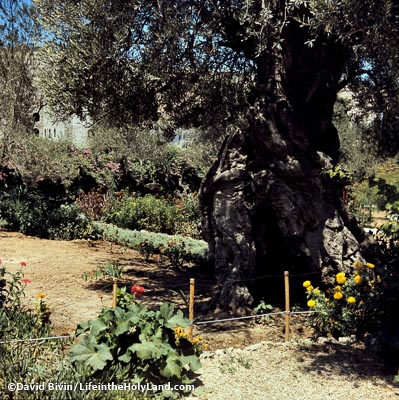
Garden of Gethsemane
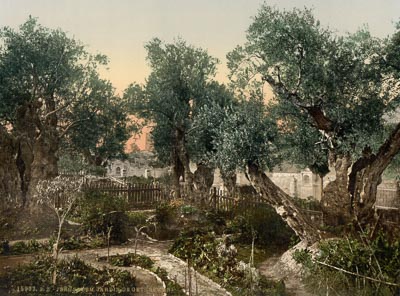
Source: The Holy Land in Photochrom
The Garden of Gethsemane
On the right-hand side of the road is the Garden of Gethsemane . . . a small enclosure surrounded by a high wall. The ground is laid out in flower beds, which are carefully tended by a Franciscan monk; but the most interesting objects are the venerable olive-trees, which are said to date from the time of Christ, and which may, in truth, be direct descendants of trees which grew in the same place at the time of the Crucifixion. A tradition, at least as old as the fourth century, identifies this plot of ground with the garden to which Jesus was wont to retire with His disciples. (Source: Picturesque Palestine, vol. 1, p. 88.)
Gethsemane, 1960's
The ancient road ascends the lower slope of Olivet for about a hundred yards, and then branches. One branch runs right up to the summit, the other turns to the right. In the angle between them is a little garden, enclosed by a high modern wall. This is the traditional, and it may be the real GETHSEMANE. At any rate, Gethsemane could not have been far distant. The garden belongs to the Latin convent. Entering, we find trim flower-beds, and gravel walks. These have no attractions for us; neither has "the bank on which the apostles slept," nor "the Grotto of the Agony," nor any other of the apocryphal "holy places," which ecclesiastical superstition has located there; but eight venerable olive-trees rivet our attention. They are real patriarchs; their huge trunks are rent, hollowed, gnarled, and propped up, and their boughs hoary with age . . . . How often have I fondly lingered there far on into the still night, when the city above was hushed in sleep, and no sound was heard save the sighing of the breeze among the olive branches, thinking and thinking on those miracles of love and power that He performed there! (Source: Jerusalem, Bethany, and Bethlehem, p. 103.)
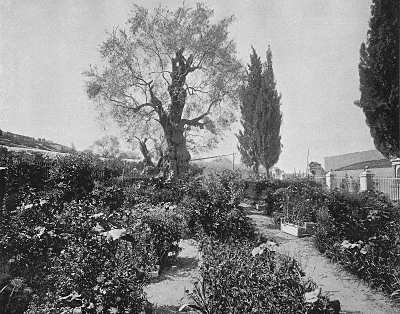
Source: Earthly Footsteps of the Man of Galilee, p. 243.
The Garden of Gethsemane
For nearly sixteen hundred years this Garden of Gethsemane, in the Valley of Kedron, has been fixed by the devout as the place of the prayer of our Savior at the time of his "agony" just before his death . . . . Since the days of the visit of the Empress Helena to Jerusalem, in the fourth century, this garden has been identified by tradition. The Valley of Kedron (Jehoshaphat) is here deep and narrow, and Gethsemane occupies about an acre of ground, to the north of which are rugged and barren heights in which the kings of Jerusalem are buried. To the west are the massive walls of Jerusalem. To the east, and rising directly above it about three hundred feet, is the Mount of Olives. The Valley of the Kedron falls into a deep ravine to the south. We have above a view of the garden within, taken by our artist on the 27th of April, 1894. It is a beautiful spot; the trees are very venerable, although they can not have been the identical trees which overshadowed the Son of Man in that hour of his distress. (Source: Earthly Footsteps of the Man of Galilee, p. 243.)
View of Garden of Gethsemane
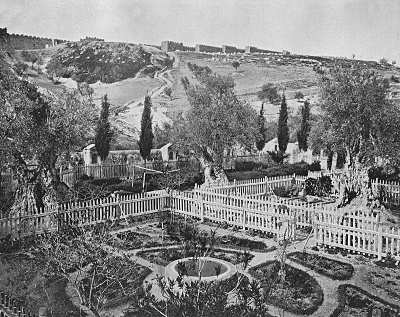
Source: Earthly Footsteps of the Man of Galilee, p. 244.
We have here another view of this celebrated garden. We see beyond it the hills and also the walls of Jerusalem . . . . No sacred place in the neighborhood of Jerusalem is so favorable to meditation and prayer. It is hidden away as a sanctuary for thought and worship. It lies in the dark depths of the historic valley. Here in the neighborhood of the tombs of kings and prophets, close by the ancient dwelling place of the poets and saints of Israel, our Savior retired to strengthen himself before passing through the valley of the shadow of death. His agony expressed itself in prayer and in blood as he felt the wretchedness which sin had brought into the world and the strength of the bonds which held man to the love and the service of sin . . . . The garden is within a stone's throw of the city. "And yet it is hushed and still, Hushed and still as the mountain-top To which He often retired to pray." (Source: Earthly Footsteps of the Man of Galilee, p. 244.)
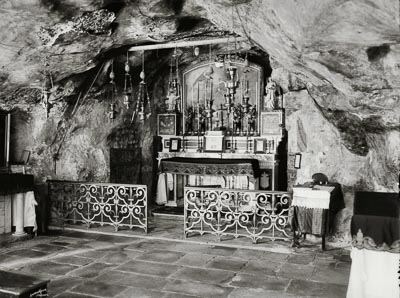
Source: American Colony: Jerusalem
Grotto of Agony
The grotto pictured here just lies just northwest of the Franciscan garden and basilica, and somewhat lower on the slope of the Mount of Olives. This grotto, which evidence suggests was venerated from early Christian times, began as a natural cave and was enlarged and altered by the hand of man over the centuries. Features of the grotto include a water channel, a cistern, and traces of Byzantine mosaic floors on two different levels. Overhead, the plastered ceiling is decorated with stars and other designs, the handiwork of Crusaders in the 12th century. The square room at the back of the cave—the altar area behind the decorative railing, as seen here—is perhaps where an oil press was installed in antiquity; a small recess in the bedrock wall (to the right of the altar, out of sight here) may have served as the fulcrum of the weighted press-beam. Despite the misleading name, this is actually the traditional location of Jesus's betrayal and arrest rather than his agonized prayers.
See also Mount of Olives, Temple Mount, Old City Gates, or Church of the Holy Sepulcher.
At BiblePlaces, see Mount of Olives
